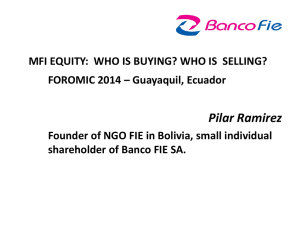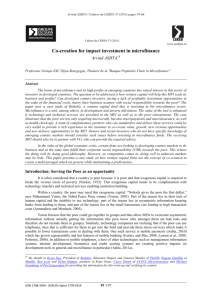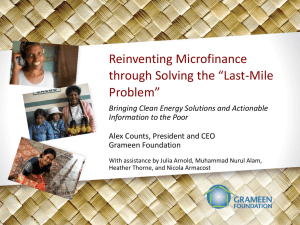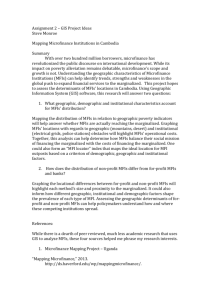A comprehensive approach of Microfinance
advertisement
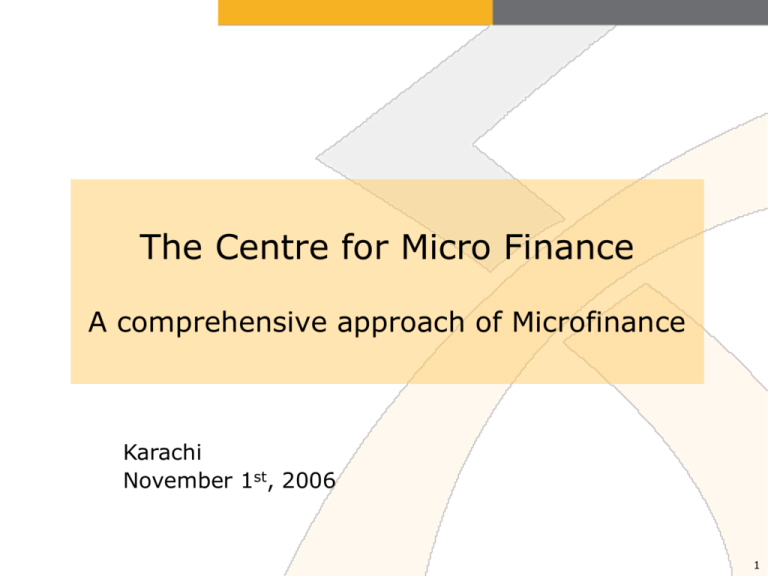
The Centre for Micro Finance A comprehensive approach of Microfinance Karachi November 1st, 2006 1 Agenda • Microfinance in India: an overview • The Centre for Micro Finance – Research Unit – MFI Strategy Unit 2 Microfinance: who are the targeted clients? HNI Middle Class Poor and vulnerable households economically at the Bottom of the Pyramid Low Income Ultra poor How can microfinance improve their lives? 3 Microfinance: what is it? Often perceived as… • Micro-credit …whereas objectives are • Suite of financial services – – – – Thrift / savings Credit Insurance and Investments Transfer Payments and Remittances • Group lending • Group and individual lending • Social/charitable activity • Sustainable activity 4 The challenge ahead: demand vs. supply gap to bridge Demand Supply • $50Bn • $1.5 Bn* • 500M un-served poor • < 2M Households reached • Several un-served areas • 60% of MF services in South • Largely urban • Mostly rural • Range of risks to be covered • Fast growing population and overall economy • Limited non-credit services * Including loans against gold • Missing market linkages / employment opportunities Improve access Increase impact 5 Constraints overcome those challenges? Information Asymmetry High Costs of Intermediation • • • • • • • • • No collateral No credit history Difficult to evaluate enterprises’ potential success Low value transactions Geographical isolation High supervision costs (no financial literacy) Informal activities: need flexible access Illiteracy: traditional services inappropriate High cash handling costs Difficult risk assessment High transaction costs How to release these constraints? 6 Thus the need for institutions’ building Finance • Venture capital for start ups • Cheaper cost of funds for on lending Systems • Product development • Technology platform • Clients’ authentication by unique ID Capacities • Staff Skills strengthening / Training • Recruiting of professionals • MFI Entrepreneurs development Research • Assess and Increase impact on poverty alleviation • Experiment and improve products 7 Agenda • Microfinance in India: an overview • The Centre for Micro Finance – Research Unit – MFI Strategy Unit 8 CMF’s objectives and mission • Established in 2005 • CMF’s objectives – To address knowledge gaps in micro finance sector – Experiment on ground solutions • CMF’s mission – Systematically research links between access to financial services and participation of poor in larger economy – Participate in maximizing access to financial services Research on micro finance and livelihood financing (RU) Strategy building for MFIs (MSU) 9 CMF’s Objectives Training Research Advocacy Influence practice Strategy building 10 MSU and RU re-enforcement loop Strategy (MSU) MFIs Strategy for growth •Definition and implementation of innovative business models –Market research, creation of linkages •MFIS best practices sharing •Design/test of new financial products •Capacity building –capital structure, HR, MIS, processes, customer segmentation, governance… Impact of microfinance • Impact Evaluation Studies • Economics of micro enterprise • Insights on HH "financial behavior" • Constraints on HH productivity • Experimentation on product design • Micro finance transaction costs Research (RU) 11 CMF collaborates with existing active players in the microfinance sector Universities/ Research Institutions Banks/Financial Institutions SMEs Manufacturing Companies Funding Organizations CDF Insurance Companies CMF CAFS MFIs/NGOs/Trust CIRM Government (Central and State) Regulators/ Policy Makers 12 Agenda • Microfinance in India: an overview • The Centre for Micro Finance – Research Unit – MFI Strategy Unit 13 Goals of Research is to maximize microfinance impact through 3 axes Understand better • Why are recovery rates so high? • What is the financial behavior of clients? • What is the impact of microfinance? • Improve organizations – Information management – Role of HR policy and staff incentives – More cost-effective processes Expand access • Alternative channels – SHGs – Revive RRBs – New channels (Kiosks, ATM, CF…) • Policy – Regulation – Competition and information sharing Improve quality of services • New and innovative products • Maximize the impact of credit through other services 14 These objectives translate into 4 Research areas to maximize microfinance impact 1 2 Impact and product design Microfinance plus Maximize impact On client 4 Policy 3 Finance and Organizational issues 15 1 Product design: credit Selection • Individual/group liability • Self/MFI selection • Guarantors • Collaterals • Interest rate Monitoring • Within group monitoring • Staff supervision Enforcement • Repayment schedule • Communication strategies • Loan size • Interest rate Design the most cost-effective products by varying credit product components 17 1 Product diversification and communication strategies Insurance •Weather •Life and Health •Livestock Savings Housing loans •Build new homes •Improve existing homes What do low income clients want? Flexible loans •Small initial sizes •Larger subsequent loans •Longer terms •Group based •Individual loans Remittances products Which delivery channels/communication strategies are effective? 18 2 Microfinance Plus: address contextual constraints Access to Financial services ? Impact •Reduce risks of MFIs by combining microfinance with other development interventions (health, financial training…) •Provide products / services through credit 20 3 Organizational issues: cost and profitability Bank 9% Transaction? 25% Micro-loan Return? • How to reduce transaction costs? • Show investors risk return performance of micro-loans 21 4 Policy issues • What are regulatory obstacles to MFIs? • What are the consequences of competition and how to manage it? • Why is there no information sharing? How can a credit bureau be set up? • How to make MFIs more transparent? • How to improve microfinance reputation? 23 Research: other initiatives Panel database • Construction of a panel database in Tamil Nadu for on-going research • With Yale Center for Economic growth (Mark Rosenzweig, Dean Karlan, Chris Udry, Paul Schultz, Rohini Pande) • 10,000 households in Tamil Nadu, rural and urban, every 4 years • Study vulnerability, consumption patterns over time • Document migration patterns, access to financial services over time • Academics and practitioners • Foregone seminars Seminar series Courses – – – – – Prof Ashok Jhunjhunwala, IIT Chennai Prof Vaidyanathan, Madras Institute of Development studies Prof Sendhil Mullainathan, Harvard GN Bajpai, ex chairman of SEBI Shekhar Shah, World Bank • Economics of micro finance, by Adel Varghese, Texas University • Evaluating social programs, by Poverty Action Lab • MBA course elective on microfinance, by Rock Rock Magleby-Lambert, Boston University • Total immersion program in Finance and development 25 Agenda • Microfinance in India: an overview • The Centre for Micro Finance – Research Unit – MFI Strategy Unit 26 MSU: Objectives and areas of work • Advice MFIs to define and execute a growth strategy by addressing their main challenges – Horizontal growth (Same Products & Same Customers Profile) – Vertical growth (New Products &/or New Customers Profile) Support MFIs growth (vertical & horizontal) Improve internal Organizational structure Diagnose Recommen d Refine Business strategy and model Impleme nt Scale up 27 MSU: Areas of work with MFIs Organizational structure 1 2 3 • Business strategy Capital structure (equity/debt) and access to financial markets (VC, securitization…) • • HR recruiting, training, incentives • • Organizational design – MIS – Processes of operations – Governance 3y strategic plan definition – Competitive position assessment (SWOT analysis) Marketing strategy – Customer segments to target – Products to develop to serve these segments (IL, insurance…) – Portfolio management 4 • Market linkages creation – Leverage of ICICI MFIs and corporations clients – Thematic consultations 28 1 Reduction of MFIs cost of funds: Supplydemand match assessment Supply Demand Identify potential assets to securitize/buy out Evaluate investors risk/return appetite for MFIs’ paper Check demand / supply requirements match Facilitate / structure the deal 29 1 4 options to explore and 4 types of players to interview to reduce MFIs costs of funds Portfolio Securitization Foreign banks Domestic banks Funds Facilitator • • • • • Bond issue Portfolio Buyout Direct medium/long term loan Minimum volume of investment? Investment currency and hedging mechanism? Tenure / maturity of investment? Pooled vs single MFI portfolio investment? Investor risk/return profile? – Portfolio / MFI rating requirement? – Guaranty requirement (FLDG/SLDG)? • • • Investment seasonality (PSL requirement)? Investor reporting / monitoring requirements? Willingness / capacity of the MFIs to receive funds and comply with investors requirements? Impact on MFIs CoF? 30 2 HR training, recruiting, incentives Organizational structure Potential partners • Recruitment: facilitate recruitment for the entire sector in the next 3-5 y => 20K FTEs to hire (TBD) • • MFIs careers, Hunt – Third sector Awareness program • Financial training for top mngt • • • IFMR centers (CAFS, insurance…) ICICI trainings HBS, Duke, IIM • Training for middle mngt & field staff • Coordinate existing providers • Incentive schemes – MicroSave, Care India, Basix school of livelihood, EDA • Set up new facilities (if required) • Cocoon? 31 3 MIS: partnership with FINO Objective Benefits for MFIs Benefits for investors Current status • To develop a common end to end delivery platform shared across Indian MFIs • Created as sectoral resource to serve 700M customers • To reduce initial CAPEX required per MFI • To improve product depth and capability • To improve business management and reduce transaction costs – data reliability and timeliness (product, clients) – To better service liabilities and investments – To allow single-window monitoring of customer relationships • To access reliable data on MFIs operations performance • Easier portfolio rating through creation of historical data • • • • Currently sized for 12-50M customers Proof of concepts completed, final contract negotiations (IBM/iflex) Entire infrastructure, hosting, operations outsourced First phase launch with 5 partners by May 2006 33 4 Market linkage creation: approach ICICI Commercial teams Corporates • Product to be sourced (retailed)? Demand − Region? Volume? Price? Quality? • Required investments (capital or capabilities) for tie up? − Expected return (in value)? − Timeframe of return? • Risk undertaken by company (quality…)? • Previous pilot already undertaken? ICICI Sectoral team Market dynamics Supply MFI • Local presence in identified region? • Willingness/Capacity of MFI to − Provide customized financial products? − Identify entrepreneurs (if necessary)? − Provide/coordinate technical training at the field level? Sectoral experts / NGOs Customers • • • • • Volume generated (absorbed)? Quality? Cost of production? Capacity to contract & payback loan? Existing capabilities/training need? 34 4 Market linkage example: cattle feed distribution through Godrej Agrovet-Spandana (1/2) • Dairy activity is a low revenue activity for farmers in spite of a growing milk demand and therefore remains a marginal source income Initial Situation – Milk yields from buffaloes is low because these are not fed good quality feed – Farmers perceive dairying as a subsidiary activity because it only offers marginal income: they have no incentive to own more that 1 or 2 buffaloes – Farmers however willing to invest in dairy (cattle feed, high quality breeds, artificial insemination…) often lack the funds to do so • Godrej Agrovet, a concentrate cattle feed producer, is not presence in the areas where Spandana (MFI with 700,000 clients) operates. Objective Challenges Expected Impact • To increase farmers revenues from milk production through improved yield and quality of milk produced by cattle feed utilization • To reduce the risk on Spandana’s loans that go toward buffalo purchase • Marketing the feed product to traditional / low income farmers and educating them to utilization of such product • Designing a credit product that caters to the clients’ needs • Expected net revenue increase in Guntur – 300-600Rs/month/household with a single buffalo fed with cattle feed – up to 2400Rs/month, ie. by 34%*, once households scale up to 4 buffalo after demonstration effect on one buffalo *: average monthly household income of 60 families surveyed was 7000Rs 35 4 Market linkage example: cattle feed distribution through Godrej Agrovet-Spandana (2/2) Demand Godrej Agrovet • Delivers concentrate feed in 50 kg bags to central locations from where Spandana receives the product • Region: Guntur • Price: 325Rs/50 Kg • Has assigned 2 officers to coordinate project Supply Spandana • Provide credit at 0% int. rate for the purchase of feed • Delivers the product to weekly center meeting • Has assigned 1 project leader • Does not make any profit out of this initiative Customers • • • • Increase yields and fat % Increase income by 10-20 Rs/day Are offered doorstep delivery Are able to purchase the feed on credit at 0% 36 4 Godrej Agrovet-Spandana: productivity improvement Initial situation After Spandana-Godrej partnership Godrej Godrej Cattle feed Distributor Spandana Cattle feed Dealer Loan Farmer Loan Farmer Piloted Spandana Sales Milk Chiller Entrp. Sales Dealer To be piloted Dairy Dairy 37 4 Market linkage creation: other projects • Handicraft • Fisheries / Seaweed • Trees plantation • Food processing • Vegetables / Mint cropping 41 Thank you For any question… annie@ifmr.ac.in or sdjari@ifmr.ac.in 42 Constraints to scaling access for the poor Information Asymmetry • No collateral • No credit history • Difficult to evaluate enterprises’ potential success High Costs of Intermediation • Low value transactions • Geographical isolation • High supervision costs (no financial literacy) • Informal activities: need flexible access • Illiteracy: traditional services inappropriate • High cash handling costs High transaction costs Provision of microfinance is constrained by… Poor Technology Regulatory Issues Staff Incentives not aligned to maximise access to financial services for poor 43 How to release these constraints? • To improve impact of microfinance on the poor • To increase access to the relevant suite of financial services 44 CMF: Who are we? • Permanent staff: 23 Research associates and 8 MSU Associates from Kennedy School, Yale, IFMR, XIMB, IRMA… • Short-term Interns: Masters and Phd students from Kennedy School, Harvard, Yale, MIT, DSE etc. • Research Committee to give advice on submitted proposals : – Jonathan Morduch (NYU), Abhijit Banerjee (MIT), Byomkesh (SKS), Mr. Thiagarajan (MCFI), Chandrasekar (IFMR), Bindu Ananth (CMFR founder) 45 CMF’s Objectives Training Research Advocacy Influence practice Strategy building 46




